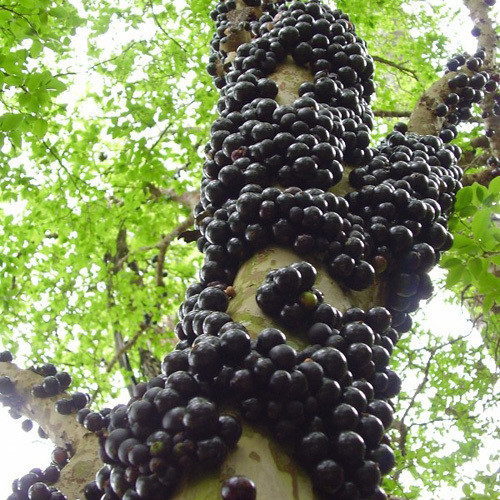
Jabuticaba fruit grows on the trunk and limbs of the tree.
In its native Brazil the Jabuticaba is by far the most popular fruit. The Dutch knew about it in 1658. Jabuticaba made it to California by 1904. It’s a common ornamental and there are many cultivars” Sabara, Paulista, Rajada, Branca, Ponhema, Rujada, Roxa, Sao Paulo, Coroa, Murta, and Mineira.
Per 100 grams Plinia cauliflora fruit has 45.7 calories, 0.11 grams of protein, 0.08 grams of fiber, 0.01 grams of fat and 12.58 gams of carbohydrates. Vitamin A is absent but it has 22.7 mg of vitamin C which is about a third of your daily need. The B vitamins are B1 (thiamin) 0.02 mg, B2 (riboflavin) 0;02 mg, and B3 (niacin) 0.21 mg. Two minerals are reported: Calcium 6.3 mg and phosphorus 9.2 mg.

Called Myrciaria cauliflora a second name for the species is Plinia cauliflora.
It’s a short tree planted in warm areas of North American and a common ornamental in Florida and the Gulf Coast. One is reported to sustain an 18F freeze and continued to thrive and fruit. Jabuticaba means “like turtle fat” referring to the fruit pulp, or, it means “tortoise place.” Take your pick. Myrciaria is from the Greek myrike (μυρίκη) which was the Greek name for the “tamarisk” a tree that is aromatic. In English it means Myrtle. Cauliflora means cauliflower-like. Plinia is Dead Latin for filled, full, rich, whole, perfect, well-equipped. You might remember from history Pliny the Elder and Younger.
Green Deane’s “Itemized” Plant Profile
IDENTIFICATION: Slow-growing tree, shrubby, usually not more than one two yards, profusely branched starting close to the ground, thin outer bark that flakes, evergreen leaves, glossy, leathery. Fruit on trunk and branches. Round or pear-shaped, tough skin, ranges from bright green to dark purple appearing to be black, slight muscadine grape flavor can be astringent. Pulp gelatinous, juicy, translucent all-white to light rose in color clinging to the seeds. Untrimmed trees fruit the best. The one you will see locally is probably the Sabara. From flower to fruit is four to five weeks.
TIME OF YEAR: All year in warm areas but heaviest in March and April or September. In some areas they fruit twice a year.
ENVIRONMENT: Jaboticaba grow best on deep, rich, well-drained soil but also grow and bare in sand over limestone. If you are going to plant some they should be 30 feet apart. They tolerate light freezes.
METHOD OF PREPARATION: Out of hand. Squeeze the fruit between your thumb and forefinger. It causes the skin to spilt making the pulp easy to get at. The seeds are edible but not usually eaten. Once harvested they ferment quickly. They can be made into wine, jelly and jam how much skin to remove is a matter of personal preference as they have tannins.

